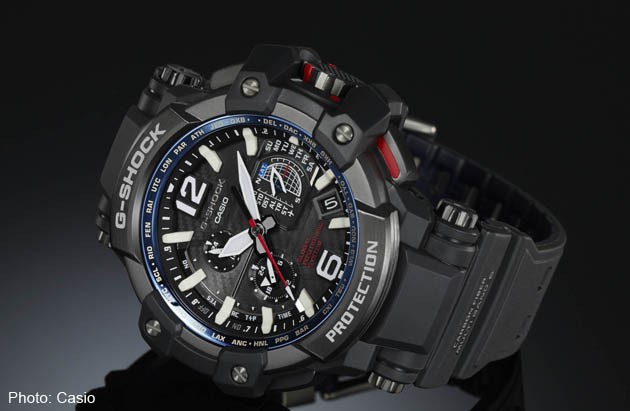Wearable review: Casio G-Shock GPW-1000

Regular globetrotters may find it a hassle to adjust their watches each time they cross time zones.
Casio's G-Shock GPW-1000 will save you that chore and, perhaps, also that If-it's-Tuesday-this-must-be-Belgium sense of dislocation.
The GPW-1000 has the world's first hybrid timekeeping system, according to Casio, which uses both Global Positioning System (GPS) and Casio's Multi Band 6 technology.
Multi Band 6 technology allows the device to receive radio signals for accurate timekeeping. As the signal towers are in the United States, United Kingdom, Germany, Japan and China, it might be a bit iffy to get those radio signals here, but there is no such difficulty getting GPS signals anywhere.
The GPW-1000 uses Casio's Tough Solar high-capacity solar-charging system. According to Casio, it takes 27 hours of direct light on the solar panel on the watch face to charge it from zero to 100 per cent. A full charge should last you seven months. However, just eight minutes under direct sunlight will keep it going for a whole day.
Being a G-Shock, the GPW-1000 is shock- and vibration-resistant, and also water-resistant down to 200m.
It comes in all-black, black/blue and orange. My personal choice is the black/blue model (version tested), because the blue dial ring and black bezel combination looks more elegant.
Regardless of the colour scheme you choose, the watch is beautifully crafted. A tough diamond-like carbon coating on the bezel protects it from scratches. The dial has 27 major cities in different time zones marked on it.
There are two subsidiary dials on the left side of the watch face. The bigger one shows the time for a second city, which is handy when you are travelling.
On the right side, an inset dial with an arrow indicates the day of the week, as well as various modes during adjustments.
All the numbers of the watch face, except "6" and "12", are indicated by luminous markers.
Scratch-resistant sapphire glass shields the watch face, while the watch bands are of resin strengthened with carbon fibre.
The build of the GPW-1000 is rock solid and the watch felt absolutely comfortable when strapped on my wrist. It is no shrinking violet. It is a bold, big and thick machine that some may find heavy. And others will find irresistibly macho.
This is not a watch for someone who simply wants to slap something on his wrist and go. It comes with a manual and you will want to keep it handy as you learn how to set up the watch. It is more complex than the Casio G-Shock Gulfmaster I reviewed recently.
When you configure the GPW-1000, you should be outdoors, preferably in an open space. The manual said GPS signals may take as long as 13min to be acquired. But the review unit got it done within 30sec.
It was intriguing to see the hour and minute hands move on their own to the exact time. The inset dial arrow also moves to show the correct day of the week.
You will need to repeat this step when you reach a new time zone. The switch does not happen automatically.
If you are stuck in the airport or somewhere where you cannot receive a GPS signal, you can manually switch time zones.
The watch's top right button activates the LED light. The button on its left lets you toggle through timekeeping, stop watch, countdown timer and alarm modes.
To keep the watch from receiving signals when in flight, hold down the button on the left for 4sec to set it to Airplane Mode. The arrow on the inset dial should then point to the airplane icon.
At $999, the GPW-1000 may seem expensive to some. But when you consider that Seiko's Astron GPS watches are priced between $2,000 and $4,000, this newest G-shock begins to look like it offers value for money.

This article was first published on Oct 15, 2014.
Get a copy of Digital Life, The Straits Times or go to straitstimes.com for more stories.